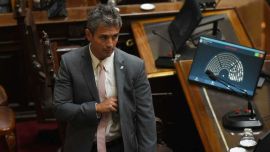You’re the leading candidate, with an even chance of taking the presidency of a country that has no macroeconomic policy credibility; where, in the scholarly words of a couple of economists, the political system suffers a “general incapacity to strike efficient intertemporal exchanges,” which inevitably “induces defective public policies.”
The country is running three-digit inflation. So what do you do? If you are an Argentine political maverick, you take the government’s discretion over economic policy away! If the political system refuses to grow up, you hand macro policy instead to the US Federal Reserve.
That, in any case, is Javier Milei’s plan. The right-wing rebel with the imposing sideburns, who stormed Argentina’s political establishment by winning last month’s presidential primary, has anchored his campaign on a proposal to slash and burn institutions, abolish the Central Bank and bring in the US dollar to replace the Argentine peso.
The proposal has received enthusiastic support from economists on the libertarian end of the profession, including a fellow Bloomberg columnist who argues that whatever the economic costs of adopting the dollar, nothing can be as bad as the mess Argentina is in now. Losing policy space to adapt to economic fluctuations, usually the most problematic side effect of ditching your currency, should, in this case, be viewed as a plus.
It may not sound unreasonable, given Buenos Aires’ track record. But the proposition has essentially been tested already. In 1989, Carlos Menem, another insurgent with equally impressive sideburns, swept into office promising to clean up an economic disaster that, at the time, included annual inflation in the four-digit range.
Argentina didn’t adopt the dollar then, but it did the next best thing. In April 1991, the so-called “convertibility plan” fixed the exchange rate at one peso per dollar, by law, and established that the monetary base would be always fully backed by international reserves, enforcing fiscal discipline by preventing the Central Bank from printing money to cover the budget deficit.
Convertibility supported macroeconomic stability for a full decade — an insanely long time given Argentina’s love affair with economic instability. But when the fixed framework collapsed in early 2002, it brought about an economic catastrophe the likes of which Argentina had probably never seen.
In the measured tones of the Argentine economists Sebastián Galiani, Daniel Heymann and Mariano Tommasi writing at the time, “in Argentina, neither discretion nor policy rigidity proved successful.”
Fans of Milei’s proposed dollarisation argue that convertibility is not the same. They point out that retaining the peso allowed the government in Buenos Aires wiggle room. It might have been narrow, but it could still be used destructively. Moreover, economic agents from households to foreign banks would operate under the assumption that laws could be changed and the plan could be undone. The promise was short of being rock solid.
But this analysis misunderstands the root cause of convertibility’s failure. It collapsed, in essence, because the economy — its households and businesses, governments and banks — could not generate enough dollars to cover the debts incurred to maintain consumption in the convertible era.
Convertibility did rein in inflation, as expected. And it drew substantial investment. The Argentine economy grew robustly at first, rebounding relatively quickly from the swoon brought about by the devaluation of the Mexican peso in December 1994 and the ensuing tequila crisis.
But there was a weakness to the arrangement. Between 1990 and 1994, private consumption in dollar terms nearly doubled, and it continued to rise for another four years. Much of this spending, however, relied on flows of dollars from abroad, fuelling large current account deficits and swelling the country’s debts.
Galiani and colleagues put the challenge thus: “The dollar value of incomes had to be sufficient to maintain spending and service debts, and for that to happen, a sufficient growth in the output of tradables had to materialise before the supply of credit dried up.” While exports did grow, they did not grow fast enough.
Then the world turned nasty. The tail end of the Asian financial crisis slashed capital flows and increased the cost of foreign borrowing. The devaluation of the Brazilian real in 1999 not only further spooked foreign capital, it also pummelled Argentina’s sales to its largest export market at the time. Then the price of commodities fell.
“Convertibility had many phases,” said Ivan Werning, an economist at MIT who has written extensively about the period. “There was a time when all went well, until 1995, then there were problems and after 1998 there were more problems.”
Between 1999 and 2001, the Argentine economy shrank by more than eight percent. Consumption crashed so steeply that by 2002 it was back at the level of the early 1990s.
For sure, the government in Buenos Aires might have done more to prevent the collapse. Fiscal policy toward the end was too profligate, especially as the economy slowed at decade’s end. But only so much fiscal belt-tightening is possible in the face of a harsh economic slowdown. Government profligacy did not bring convertibility down.
It is a dubious proposition that ditching the peso altogether and adopting the dollar would have allowed Argentina to hold on. It rests on the fantasy that a dollarised Argentina would have kept attracting foreign money regardless of its economic realities. And like convertibility, Werning points out, dollarisation can be reversed too.
The better lesson to draw from convertibility’s collapse is that the monetary straightjacket was way too costly. The dollarisation of pretty much every contract in the economy led to a chaotic domino effect of insolvencies once the dollar peg was abandoned in 2002. And when the dust settled the government was left with the same policy credibility it had before its adoption: zero.
Given the history, the enthusiasm of voters for Milei’s proposal to again take control of monetary policy away from the Argentine government and hand it to the Fed is hard to comprehend. Myopia, perhaps? The costs of that distant shock have faded into history, trumped in voters’ minds by the inflationary stress they must contend with every day.
But the idea is as shortsighted as it was back then. Once everybody stops hyperventilating about the dollar, Argentina’s voters might realise that they don’t need some deus ex-machina to restore macroeconomic stability. They need run-of-the-mill, sensible political institutions that can reach the medium- and long-term agreements any government needs to run an economy.
Just encouraging longer term thinking would help stabilise the ship. So would ensuring that checks and balances work. Building a professional bureaucracy with fewer rotating political appointees is one idea. Encouraging legislators to stay in Congress to develop some relationships and expertise, rather than leaving to continue political careers elsewhere is another.
Longer tenures for Supreme Court judges could help ensure the court acts as a check on the other branches of government rather than a friend of the administration that appointed them. Establishing reasonable limits on the discretionality in the federal funding of the provinces could prevent the trading of favours and short-term political gamesmanship.
The dollar might seem like a killer app. But voters in Argentina should consider the story of their Latin American neighbours. Not long ago most of them shared Argentina’s instability. Most still face many problems — poverty, inequality, corruption among them. But Argentine volatility is one they have largely overcome. And most didn’t need the greenback to get there.
Argentina could do that, too. “I would try it,” Werning noted. “Because the costs of convertibility are very high.”
* Eduardo Porter is a Bloomberg Opinion columnist covering Latin America, US economic policy and immigration
related news
by Eduardo Porter, Bloomberg


























Comments